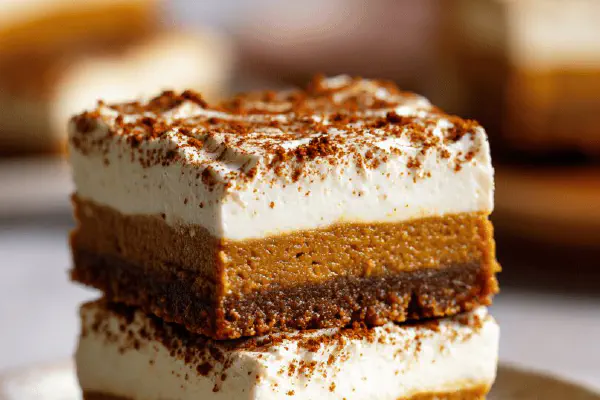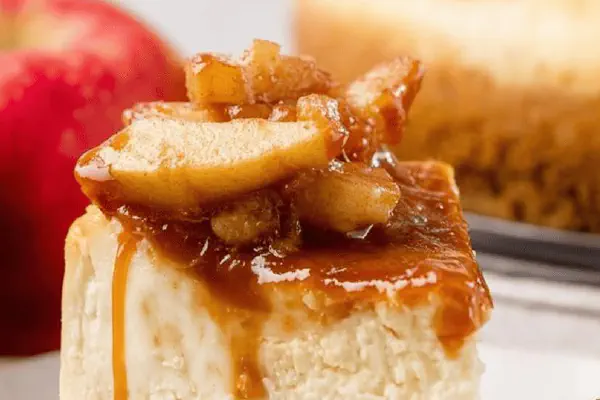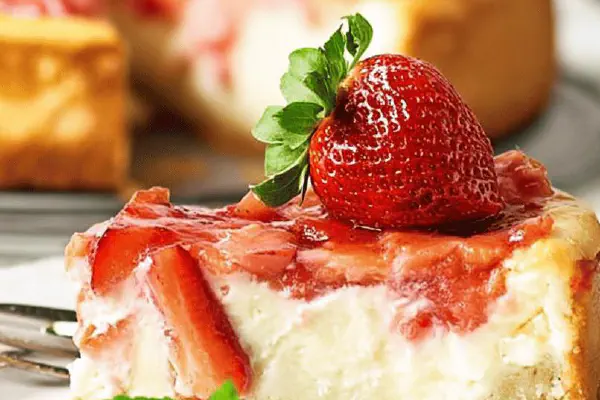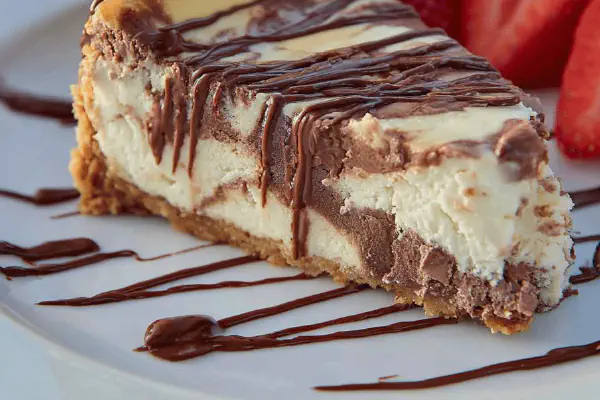Molasses Pumpkin Cheesecake Bars

By Emma
Certified Culinary Professional
Ingredients
Crust
- 150 g (1 cup) crushed gingersnap cookies or graham cracker crumbs
- 90 g (6 tbsp) unsalted butter, melted
- 25 ml (1 1/2 tbsp) molasses
Filling
- 2 blocks (200 g each) cream cheese, softened
- 80 g (1/3 cup) coconut sugar
- 65 ml (1/4 cup) plain oat yogurt
- 4 ml (3/4 tsp) vanilla extract
- 3 large eggs, room temperature
- 150 ml (2/3 cup) pure pumpkin puree
- 50 ml (3 tbsp) molasses
- 1 ml (1/4 tsp) ground cinnamon
- 1 ml (1/4 tsp) freshly grated nutmeg
About the ingredients
Method
Crust
- Set oven rack mid-level and preheat oven to 175 °C (350 °F). Butter a 33 x 23 cm (13 x 9 inch) baking pan. Line with parchment overhang on two opposing sides to lift bars later.
- Combine crushed gingersnap crumbs with melted butter and molasses until sandy but holds when pressed. Press firmly and evenly across bottom. Bake 10 minutes, edges lightly browned and aroma deepening. Remove to cool slightly while oven temp dropped to 160 °C (320 °F).
Filling
- Using a stand mixer fitted with paddle beater, blend cream cheese and coconut sugar on medium speed. Stop, scrape sides. Add oat yogurt, vanilla, and two eggs. Mix just until uniform with small air bubbles, no lumps. Avoid overbeating, which traps air and causes cracking.
- Pour about 500 ml (2 cups) of this mixture evenly over cooled crust. Smooth but do not disturb surface.
- In same mixer bowl (no washing needed), whisk remaining filling mixture: pumpkin puree, molasses, cinnamon, nutmeg, and last egg. Keep mixing until creamy and no streaks. Spoon and gently spread over first layer. No worries if swirls form between layers.
- Bake 35-40 minutes. Watch edges - set while center still slightly jiggly but no wetness visible. Toward end, aroma of spices fills kitchen, top should firm up with light golden tint but not brown. A toothpick near center should come out mostly clean, some moist crumbs allowed.
- Cool in pan 1 hour or until lukewarm. Cover loosely with foil then refrigerate minimum 3 hours or overnight.
- To serve, run thin knife along pan edges to loosen. Lift bars using parchment overhang carefully onto cutting board. Cut into 15 equal portions with a sharp knife wiped clean between cuts to preserve neat edges. Store airtight in fridge; best eaten within a week.
Tips & substitutions
- Gingersnap crumbs add spice and crunch to crust, but classic graham crumbs work perfectly. Butter amount can be adjusted slightly to get proper crust hold; too little results in crumbly base.
- Unsweetened pumpkin puree preferred for balanced sweetness; canned pie mix too sweet and spice-heavy.
- Coconut sugar adds caramel undertones replacing cassonade; plain brown sugar can substitute but texture varies slightly.
- Oat yogurt lends mild tang and creaminess without dairy; Greek yogurt ok but may firm up bars more.
- Molasses depth sets this apart. If unavailable, use dark corn syrup or maple syrup but reduce quantity by 1 tbsp as they’re sweeter.
- Monitor baking visually; ovens vary. Avoid overbaking, which will dry out edges and crack top. Slight jiggle at center means just right.
- Using parchment overhang crucial for clean lift and less breakage.
- Let bars chill at least 3 hours for firm slicing. Rushing this step risks crumbling.
- For extra flair, sprinkle roughly chopped toasted pecans or drizzle melted dark chocolate on top before chilling.
Cooking tips
Chef's notes
- 💡 Press crust firmly. Sandy feel means correct butter balance. Too loose crust cracks when cutting. Gingersnap crumbs add texture and warm spice; graham cracker crumbs are less bold but work. Chill crust slightly after baking before pouring filling layer. Oven rack mid-level avoids bottom burning but browns top slowly. Watch edges for doneness to avoid dry texture.
- 💡 Separate filling in two bowls. Cream cheese and sugar first on medium speed—don’t overbeat. Avoid air bubbles; they cause top cracks. Add yogurt and eggs gently next. Pumpkin puree mix with molasses, cinnamon, nutmeg in second bowl. Spoon pumpkin layer gently over cheese layer; swirls welcome. No smoothing needed—rustic look forms naturally.
- 💡 Bake until edges firm and golden, center slightly jiggly. Toothpick test must show moist crumbs but no raw batter. Expect aroma of molasses and cinnamon rising near end bake. Crackling sound from crust signals advance. Cool 1 hour in pan, then refrigerate minimum 3 hrs for proper set. Rushing this step ruins texture, makes bars crumbly or gooey.
- 💡 Use parchment paper with overhangs on two sides for easy lift. Thin knife run along pan edges before removing bars prevents breakage. Keep knife wiped clean between cuts to maintain neat edges. Bars best eaten within a week refrigerated. Bring to room temp 10 minutes before serving to soften firm chilled texture without meltdown.
- 💡 Substitute dark corn syrup or maple syrup for molasses—reduce quantity by 1 tbsp to prevent excessive sweetness. Greek yogurt usable instead of oat but bars firm more. Unsalted butter preferable; salt affects crust balance. Keep cream cheese softened but cold, lumps come from warm cheese melting inconsistently. Oven temps tweaked lower from standard to avoid cracked tops and dry edges.
Common questions
How to avoid cracked top?
Don't overmix eggs. Stop mixing when uniform but slightly dense. Air bubbles trap heat, cause cracks. Oven temp slightly lower helps. Also cream cheese temp matters; soften but not warm. Bake time watch carefully but rely on jiggle center cue; too long dries edges causing cracks.
Can I swap coconut sugar?
Brown sugar works but texture changes. Coconut sugar caramel tone differs. Adjust sweetness accordingly; brown sugar sweeter. Keep eye on crust firmness, butter ratios might need tweaking. Oat yogurt can switch to Greek but expect denser bars. Any swap alters moisture and texture slightly; test small batch if uncertain.
Why does crust crumble?
Usually not pressed firm or butter not enough. Sandy feels but loose base leads to crumbs when cut. Press firmly with hand or bottom of glass. Let crust cool before pouring filling so butter solidifies. Overbaking crust causes dryness. Adding some gingersnap crumbs adds bite but also binds better than plain graham crumbs.
Best storage method?
Wrap bars airtight in fridge. Kept covered to avoid absorbing fridge odors. Can freeze individually wrapped then thaw in fridge overnight before serving. Refrigerated bars stiffen; bring to room temp 10 min prior eating for softer texture. Keep knife clean when cutting to maintain neat bars. Avoid long storage over a week; sugar and dairy content vary shelf life.



